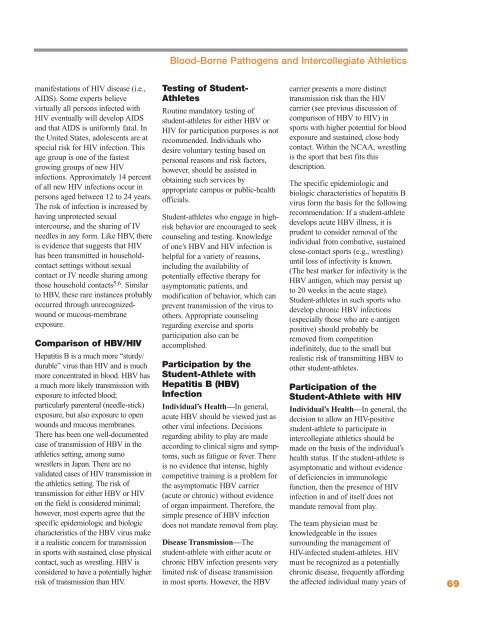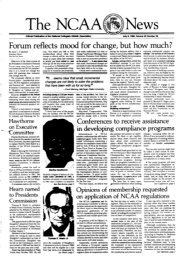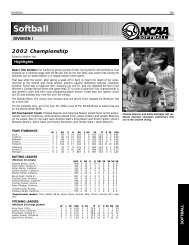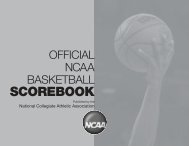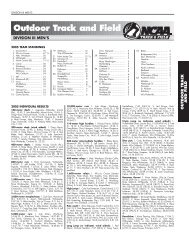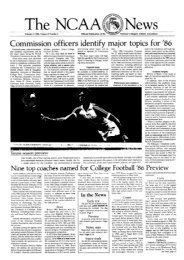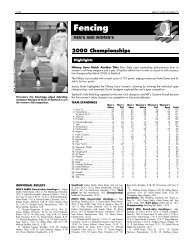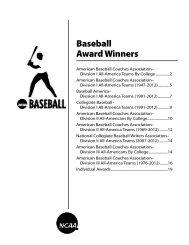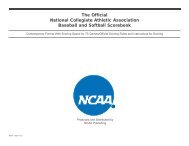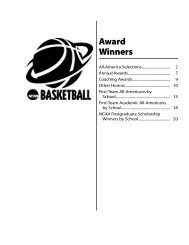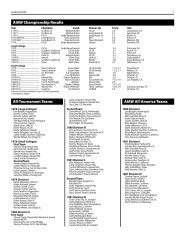Sports Medicine Handbook - NCAA
Sports Medicine Handbook - NCAA
Sports Medicine Handbook - NCAA
Create successful ePaper yourself
Turn your PDF publications into a flip-book with our unique Google optimized e-Paper software.
manifestations of HIV disease (i.e.,<br />
AIDS). Some experts believe<br />
virtually all persons infected with<br />
HIV eventually will develop AIDS<br />
and that AIDS is uniformly fatal. In<br />
the United States, adolescents are at<br />
special risk for HIV infection. This<br />
age group is one of the fastest<br />
growing groups of new HIV<br />
infections. Approximately 14 percent<br />
of all new HIV infections occur in<br />
persons aged between 12 to 24 years.<br />
The risk of infection is increased by<br />
having unprotected sexual<br />
intercourse, and the sharing of IV<br />
needles in any form. Like HBV, there<br />
is evidence that suggests that HIV<br />
has been transmitted in householdcontact<br />
settings without sexual<br />
contact or IV needle sharing among<br />
those household contacts 5,6 . Similar<br />
to HBV, these rare instances probably<br />
occurred through unrecognizedwound<br />
or mucous-membrane<br />
exposure.<br />
Comparison of HBV/HIV<br />
Hepatitis B is a much more “sturdy/<br />
durable” virus than HIV and is much<br />
more concentrated in blood. HBV has<br />
a much more likely transmission with<br />
exposure to infected blood;<br />
particularly parenteral (needle-stick)<br />
exposure, but also exposure to open<br />
wounds and mucous membranes.<br />
There has been one well-documented<br />
case of transmission of HBV in the<br />
athletics setting, among sumo<br />
wrestlers in Japan. There are no<br />
validated cases of HIV transmission in<br />
the athletics setting. The risk of<br />
transmission for either HBV or HIV<br />
on the field is considered minimal;<br />
however, most experts agree that the<br />
specific epidemiologic and biologic<br />
characteristics of the HBV virus make<br />
it a realistic concern for transmission<br />
in sports with sustained, close physi cal<br />
contact, such as wres tling. HBV is<br />
considered to have a potentially higher<br />
risk of transmission than HIV.<br />
Blood-Borne Pathogens and Intercollegiate Athletics<br />
Testing of Student-<br />
Athletes<br />
Routine mandatory testing of<br />
student-athletes for either HBV or<br />
HIV for participation purposes is not<br />
re commended. Individuals who<br />
de sire voluntary testing based on<br />
personal reasons and risk factors,<br />
however, should be assisted in<br />
obtaining such services by<br />
appropriate campus or public-health<br />
officials.<br />
Student-athletes who engage in highrisk<br />
behavior are encouraged to seek<br />
counseling and testing. Knowledge<br />
of one’s HBV and HIV infection is<br />
helpful for a variety of reasons,<br />
including the availability of<br />
potentially effective therapy for<br />
asymptomatic patients, and<br />
modification of behavior, which can<br />
prevent transmission of the virus to<br />
others. Appropriate counseling<br />
regarding exercise and sports<br />
participation also can be<br />
accomplished.<br />
Participation by the<br />
Student-Athlete with<br />
Hepatitis B (HBV)<br />
Infection<br />
Individual’s Health––In general,<br />
acute HBV should be viewed just as<br />
other viral infections. Decisions<br />
regarding ability to play are made<br />
according to clinical signs and symptoms,<br />
such as fatigue or fever. There<br />
is no evidence that intense, highly<br />
competitive training is a problem for<br />
the asymptomatic HBV carrier<br />
(acute or chronic) with out evidence<br />
of organ impairment. Therefore, the<br />
simple presence of HBV infection<br />
does not mandate removal from play.<br />
Disease Transmission—The<br />
student-athlete with either acute or<br />
chronic HBV infection presents very<br />
limited risk of disease transmission<br />
in most sports. However, the HBV<br />
carrier presents a more distinct<br />
transmission risk than the HIV<br />
carrier (see previous discussion of<br />
comparison of HBV to HIV) in<br />
sports with higher potential for blood<br />
exposure and sustained, close body<br />
contact. Within the <strong>NCAA</strong>, wrestling<br />
is the sport that best fits this<br />
description.<br />
The specific epidemiologic and<br />
biologic characteristics of hepatitis B<br />
virus form the basis for the following<br />
recommendation: If a student-athlete<br />
develops acute HBV illness, it is<br />
prudent to consider removal of the<br />
individual from combative, sustained<br />
close-contact sports (e.g., wrestling)<br />
until loss of infectivity is known.<br />
(The best mark er for infectivity is the<br />
HBV antigen, which may persist up<br />
to 20 weeks in the acute stage).<br />
Student-athletes in such sports who<br />
develop chronic HBV infections<br />
(especially those who are e-antigen<br />
positive) should probably be<br />
removed from competition<br />
indefinitely, due to the small but<br />
realistic risk of transmitting HBV to<br />
other student-athletes.<br />
Participation of the<br />
Student-Athlete with HIV<br />
Individual’s Health—In general, the<br />
decision to allow an HIV-positive<br />
student-athlete to participate in<br />
intercollegiate athletics should be<br />
made on the basis of the individual’s<br />
health status. If the student-athlete is<br />
asymptomatic and without evidence<br />
of deficiencies in immunologic<br />
function, then the presence of HIV<br />
infection in and of itself does not<br />
mandate removal from play.<br />
The team physician must be<br />
knowledgeable in the issues<br />
surrounding the management of<br />
HIV-infected student-athletes. HIV<br />
must be recognized as a potentially<br />
chronic disease, frequently affording<br />
the affected individual many years of<br />
69


